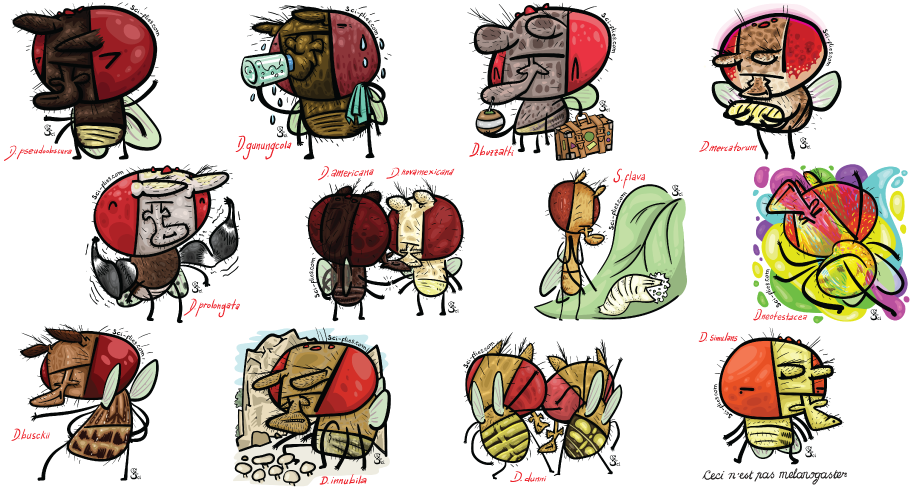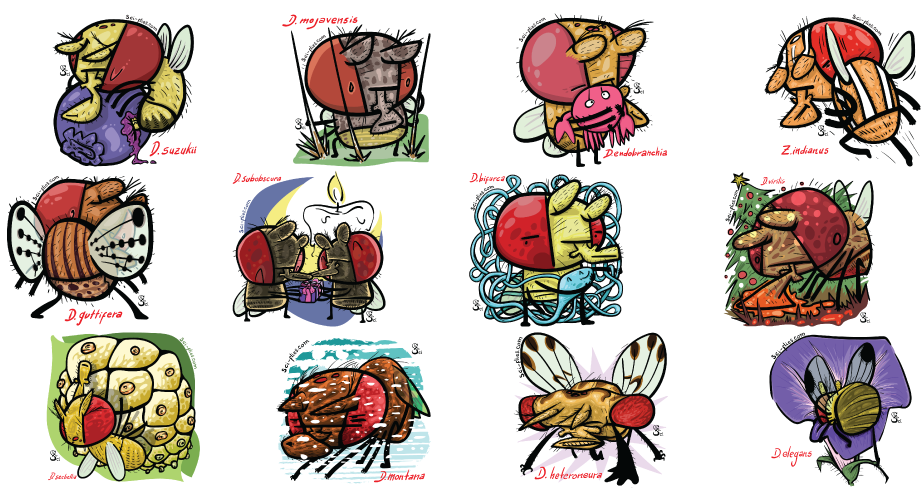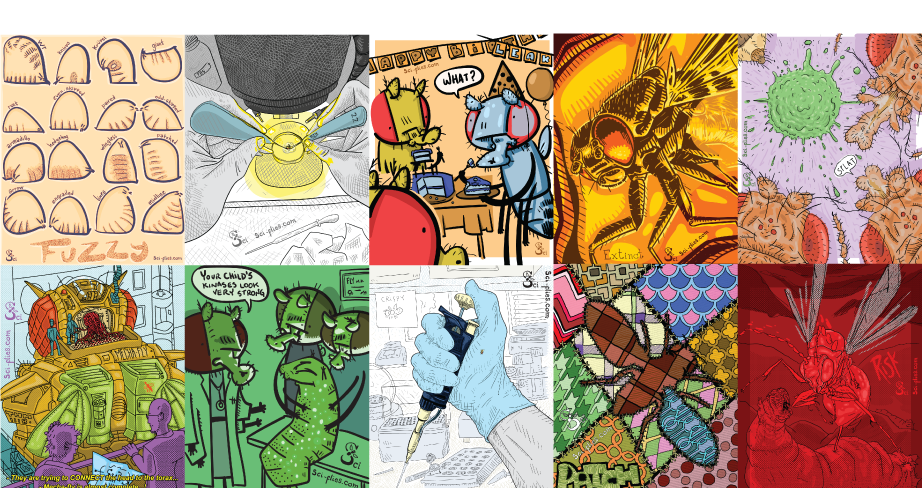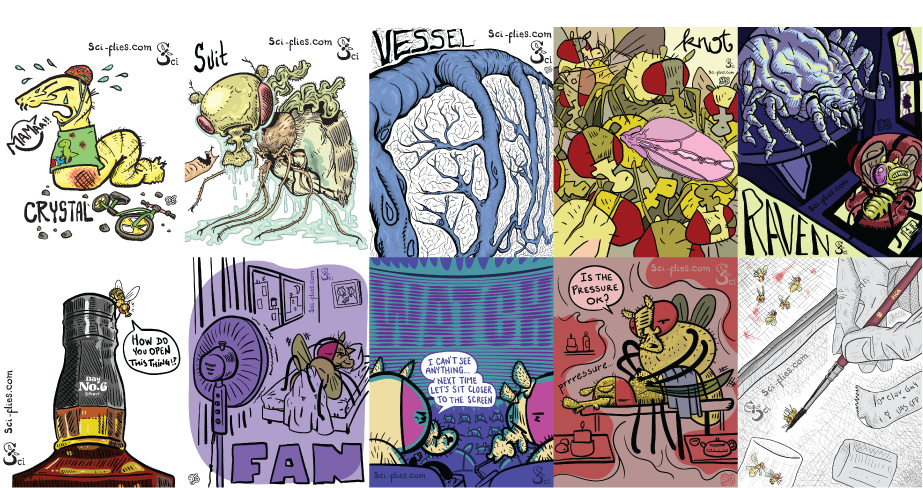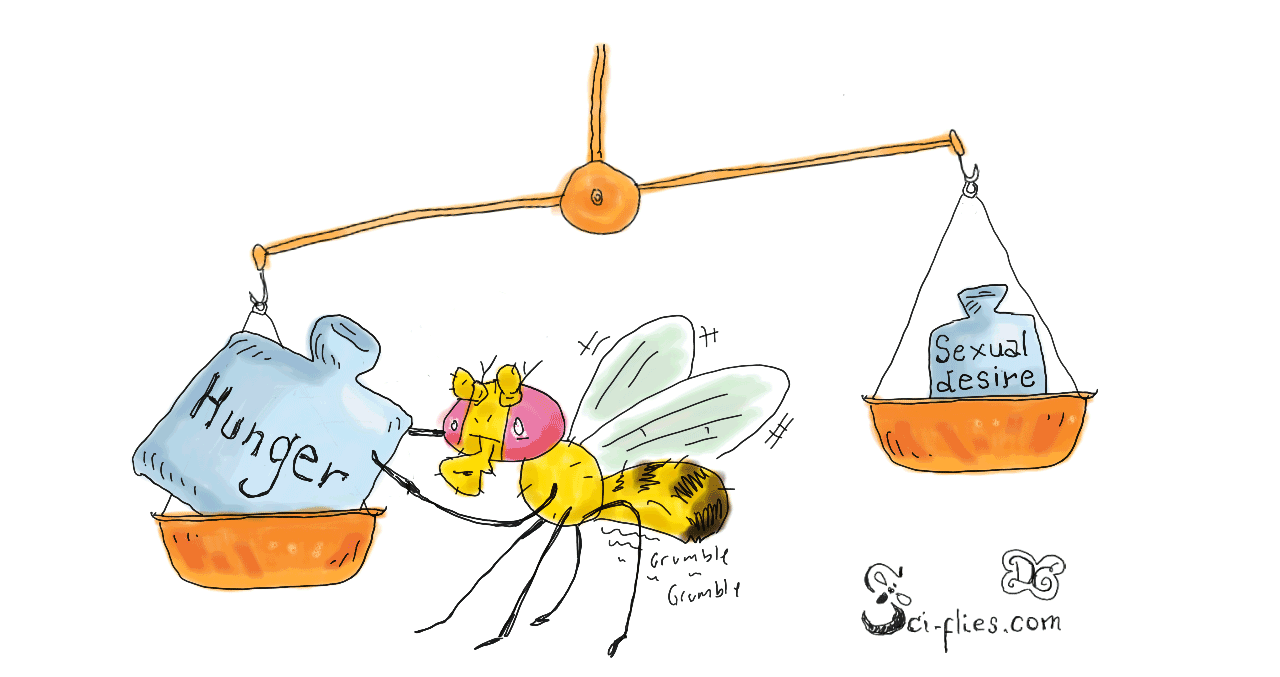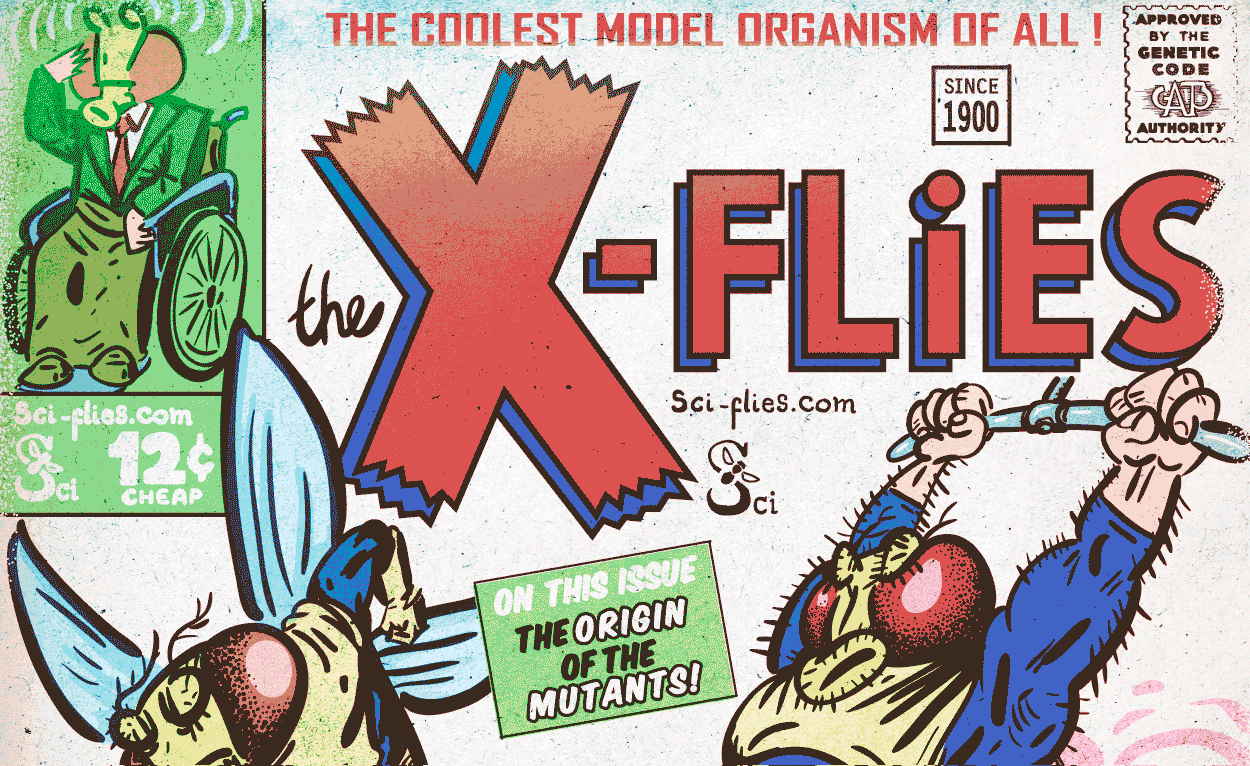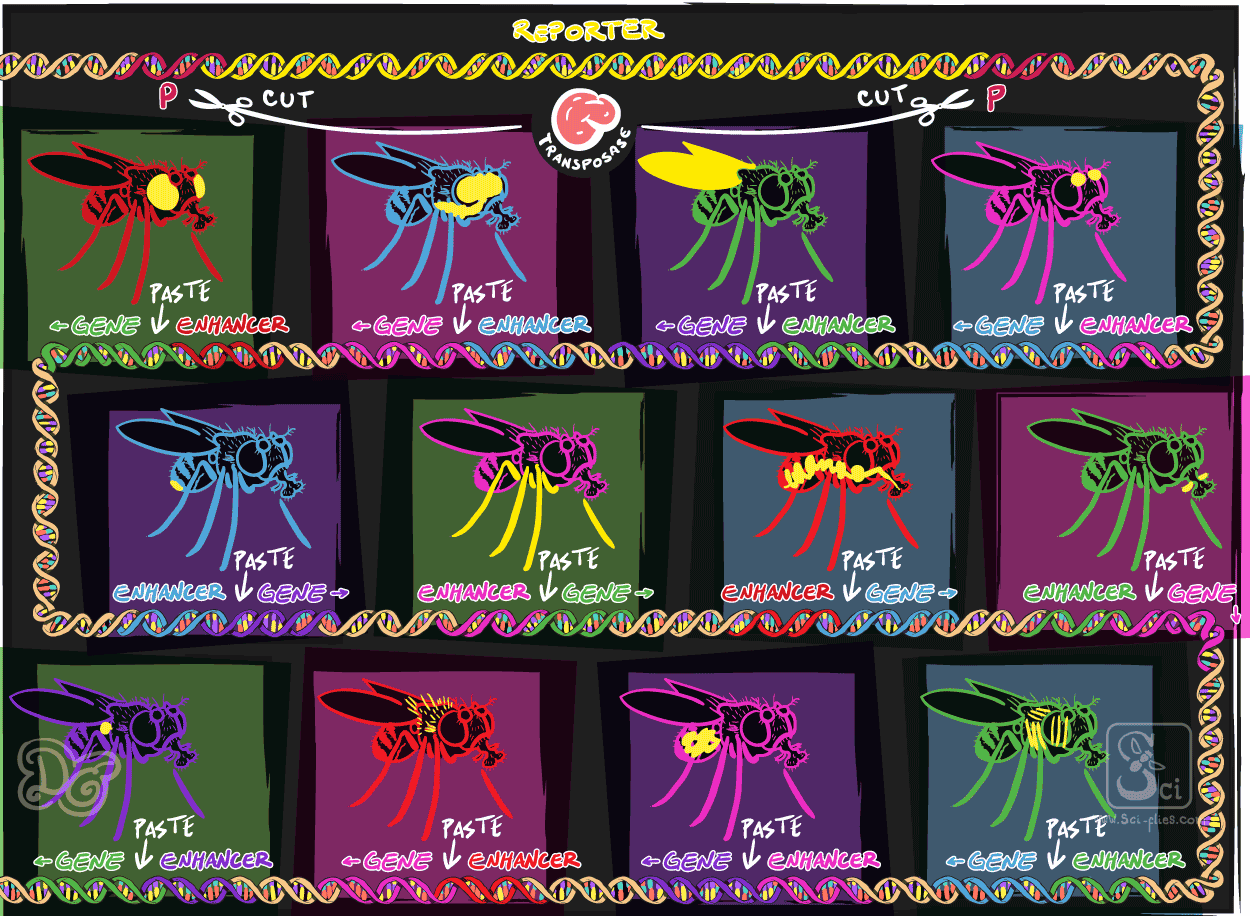Moving Forward - Behaviors and Neurogenetics
On the last post we described the first studies aimed at understanding whether behaviors are determined by genetic information and how. The start was signaled by the revolution in science, and particularly in biology, caused by the discovery of the mendelian laws of inheritance and their connection to Darwin’s proposed explanation for evolution (natural selection).
We also talked about how this subject of study was perverted and used as the base for a pseudoscience called Eugenics, that justified discrimination, stigmatization and outright elimination of targeted groups of society that they deemed unfit and undesirable in the genetic pool of humanity. Eugenics was a purposely wrong interpretation of scientific data and procedures to justify old prejudice. It led to the death of millions of human beings.
After those dark days, the study of behavior became more focused on how the environment shapes it. Some researchers went all the way to the other side, to propose that behaviors were a product of the environment and genetics had nothing to do with it. Finally, at the end of the 50s Hirsch made complex selection experiments with flies that demonstrated that stereotypical behaviors of the flies had a genetic component that could be isolated and assigned to specific chromosomes and parts of the chromosomes. Behaviors are complex, variable and have a genetic component, consisting probably of many genes for each particular behavior.
So, how did this story continue?
Seymour Benzer – The molecular revolution gets to behaviors
At the beginning of the 1950s Biology went through another revolution, the molecular revolution. DNA was determined as the source of genetic information. Its molecular structure was deciphered, leading to understanding its mechanisms of replication and its relation to the production of RNA (transcription). Further studies determined some mechanisms of regulation and the relationship of DNA and RNA with proteins (you can revisit my conceptual take on DNA).
Amongst the scientists that made these incredible discoveries and contributions was Seymour Benzer. He was a physicist but went into biology after reading a book by another physicist, Erwin Schrödinger (the one with the cat) in which he proposed all the properties a molecule should have to carry hereditary information (this was years before the structure of DNA was described)
So Benzer got interested in studying the molecular nature of genes and how they carry information. He worked at Max Delbruck’s laboratory (a later Nobel Laurate) with a type of virus that infects bacteria. In his experiments he used the same reasoning applied with flies at Morgan’s laboratory to understand the linear structure of chromosomes, but at a smaller scale. This way Benzer succeeded in describing the structure of genes. He showed that a gene is a linear molecule and that mutations can be modifications in as little as one of its basic elements (remember the “letters” or colored circles in my conceptual take).
Max Delbruck headed an informal group of scientists from different laboratories called the Phage Group. They were all using bacteria and Phage viruses as a model to understand the molecular mechanisms of genetic information. They made foundational discoveries that began molecular biology and kickstarted the molecular revolution in Biology. Amongst these scientists were Salvador Luria, Alfred Hershey, Matthew Meselson, James Watson, Renato Dulbecco, Seymour Benzer and Sydney Brenner.
After that work Benzer established his own laboratory. This time he got interested in behaviors, particularly on how the pieces that make up an organism can produce a behavior. He had read another book (I mean relevant to this story, I am sure he read many more), this time about discoveries in neurology and anatomy related to behaviors (The Machinery of the Brain by DE Wooldridge). In it, many cases were presented, showing how parts of the brain and specific nerves and connections are involved in the perception of the world. It described how disconnecting or damaging specific parts or nerves could produce changes in behavior. With his experience on molecular biology and genes he decided to try a go at the old questions of whether the units that carry information to make the organisms –the genes-, were involved in controlling behaviors and how.
Benzer was working at the same institute where Morgan had had his Fly Room. There EB Lewis, a disciple of Morgan’s student Sturtevant, was still working with flies and keeping the collection of mutants (EB Lewis had already made amazing discoveries in developmental biology). Looking at Lewis’ flies, Benzer realized that they were perfect for what he wanted to study and devised an experimental approach to discover individual genes involved in controlling specific behaviors. His approach needed.
- An easy method to make mutation in genes at random.
- Mutations in single genes (as opposed to gross damage to many genes at once).
- Animals that could be obtained in high numbers and fast.
- Behaviors that were simple, easy to test and easy to measure.
His approach is now known as Forward Genetics and allows to discover genes that control biological processes. This approach focuses on the biological process and tries to take it apart to reveal its main components. It can be broken down in steps as follows:
FIRST
Establish a defined observable biological phenomenon that repeats regularly and we want to study. For example, a specific behavior.
Benzer chose the phototactic behavior of flies. It was well established that flies move towards sources of light.
SECOND
Design an experimental way to describe or measure this phenomenon (this behavior).
Benzer made a device called a Countercurrent Apparatus (the name comes from a chemical technique to separate mixed liquids that uses a similar logic).
In this video you can see the same apparatus but used to test another behavior, geotaxis (movement against gravity, away from the ground, instead of phototaxis). In phototaxis it is placed horizontally with a light source on one side.
He tested that his apparatus worked by using positive controls. These are subjects (in this case flies) that we already know behave differently from the normal subjects (flies). In this case, the positive controls were flies with clipped wings, which were known to walk less towards light.
His apparatus consisted of two rows of 15 glass tubes that can slide one in front to the other to connect the openings of the tubes from both rows.
The apparatus is placed horizontally, with a front row of tubes close to a light source and a back row of tubes further away from the light source.
To understand how it works let’s call the front row with letters A-B-C-D… and the back row with numbers 1-2-3-4…
Flies start on the first tube of the back row, tube 1. The first tube of the front row, tube A, is connected to 1 and a light is shined from the front side. Flies will start to move towards the light (from tube 1 to tube A).
After some time, we slide the top row over to the right to connect A to 2. The flies in A are then moved to the back tube (the number tubes) by putting the apparatus vertically and banging it down against the table (this way flies fall to the back tubes). Then we slide back the front row to the left to connect A to 1, B to 2 and so on.
After that we shine the light again, and repeat. As cycles continue flies that are attracted to light will repeatedly move over to the tubes to the right. If flies are slow to move or not attracted to light, they will stay behind and remain on the first tubes (to the left).
At the end, if the flies are normal and very attracted to light, the tubes closer to the end of the rows (the last tubes to the right) will have more flies than the ones at the beginning (A and 1).
THIRD
Generate variants of the organisms (called lines or stocks in flies) that have mutations in single genes at random.
Guided by Lewis, Benzer used a chemical (ethyl methane sulfonate or EMS) that can generate subtle damage to DNA and mutations in single genes.
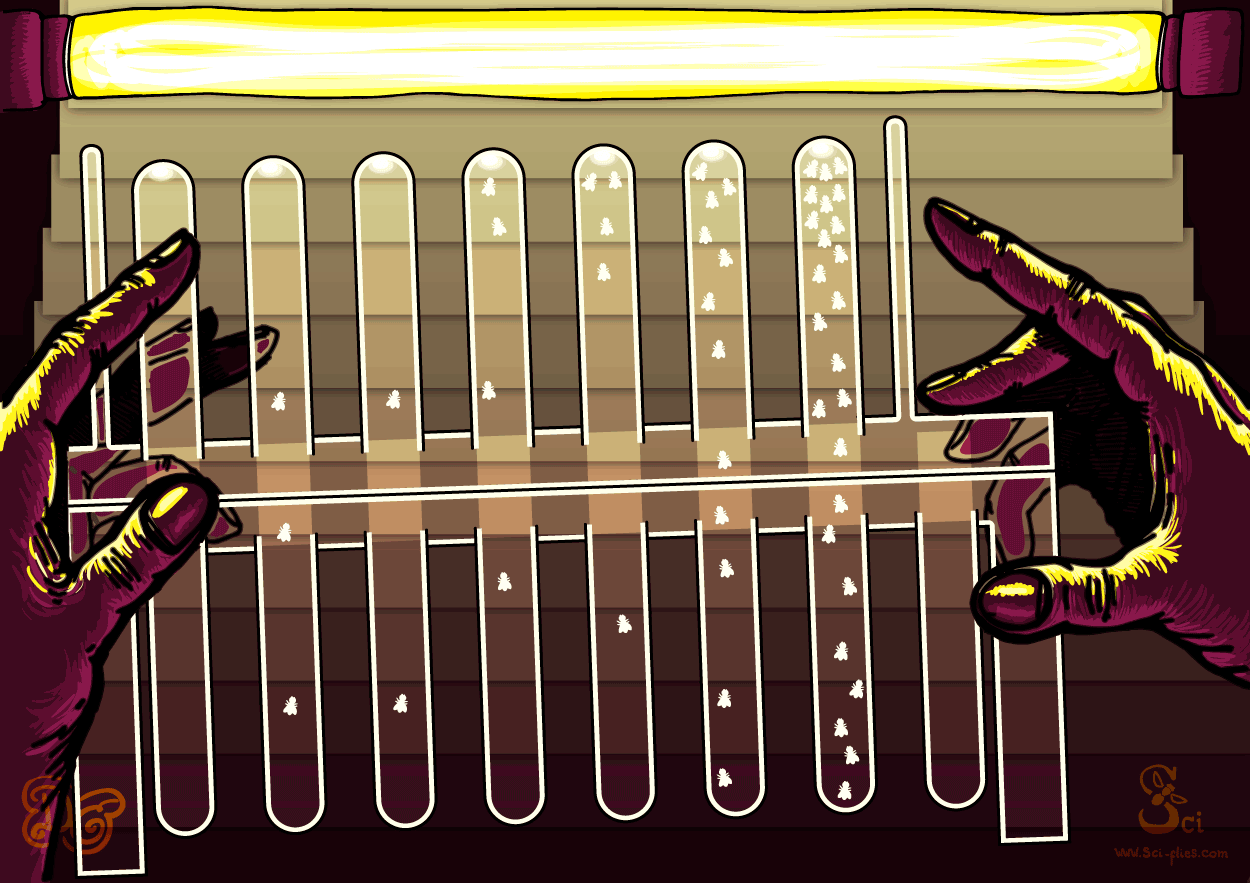
FOURTH
Test the mutants with the device or method.
Once the mutant lines were established, they were tested with the apparatus and procedure described above. Flies with mutations in genes that are important for phototaxis behavior would have a reduced attraction to light and would end in the first tubes to the left of each row, closer to the starting point. Benzer established 26 suspected mutant lines and found 2 good candidates that did not move towards the light.
You could think of this method like breaking the pieces of a machine one at a time to see which pieces make the machine work in a different way or not work at all.
But what if, like in Benzer’s experiments, you break the pieces without knowing which you are actually breaking? After the tests you must find a way to determine which pieces were broken (like opening the machine and looking into it). Using genetic crosses similar to Mendel’s and Morgan’s (a technique called genetic mapping which I will explain in the future) allowed Benzer to determine where in the genome those mutations were located.
In 1967 Benzer published his results. This was a seminal work that demonstrated that single genes can control behaviors, and it provided the proof of concept of how to discover genes for other behaviors using the forwards genetics approach (useful also for other biological processes. We’ll see a lot of this in future posts).
The work by Hirsch had shown that there were genes all over the genome involved in behaviors that is to say, that behaviors were complex phenomena controlled in a multigenic manner. In the context of Benzer’s idea, that was very important. Since Benzer was interested in uncovering single genes involved in behavior, he had to make sure that his lines did not have differences in any other part of the genome.
Benzer had to make sure that the only variable with differences between the tested flies was the single mutations he was testing (remember what dear Francesco Redi taught us). To avoid having effects from more than one unknown gene, the rest of the genome had to be identical (we call this an isogenic genetic background).
To make sure of this he used a single line of flies to produce the mutants. This line had been tested to behave very good in phototaxis. That line was later used as his control in all the experiments, and it is still widely used in behavioral experiments to this day.
No time to waste – The genetics of the Biological Clock
After Benzer’s publication, Ron Konopka joined his laboratory as a PhD student. He was interested in using Benzer’s approach to study the internal biological clock.
What is this?
Practically every single living organism studied so far has, to some extent, the capacity to keep track of time. Many plants open and close their leaves or flowers following the day-night cycles. Many animals prepare to sleep or wake up, becoming more or less active to the beat of the shifts from night into day and back. These rhythmic activity patterns are known as circadian rhythms because they repeat at a period of around 24 hs (“circa” means “close to” and “dian” refers to “the length of a day”).
In the early 1970s, it was already known that animals and plants can keep that rhythm of around a day, and cycle through periods of high and low activity, even in the absence of clues from the environment, such as knowing if the sun was out or not, in situations of constant temperature or even without the influence of the rotation of the earth. In many cases it had also been shown that these rhythmic activity patterns were innate, and not learned from parents or other organisms.
So, if the stimulation that produced the rhythmic changes in activity did not come from the environment (from outside), and was innate (hereditary), then there had to be an internal mechanism controlling it, and it had to be coded in the genes. As you might expect, we call this internal mechanism, the internal clock.
To Ron Konopka, Benzer’s approach appealed as the perfect way to smash the clock and see what it was made of.
FIRST
What rhythmic behavior do we study?
During the life cycle of the fly there is a period called metamorphosis, when the larva becomes a pupa to transform into an adult fly. This transformation occurs inside the puparium, a hard capsule-like structure that forms the shell of the pupa. When the transformation is over, the adult fly breaks the capsule and emerges to the outside world. If we have a group of pupae most of them will emerge early in the morning, and less will do it as the day continues.
In fly research we do genetic crosses mating male flies with virgin female flies. This is because when flies copulate the female stores the sperm from the male to fecundate the eggs as continues producing them later. This way, a female that is not virgin will have sperm from unknown males inside of her, messing up the results of the crosses.
To get virgin females for experiments, the best time of the day is early in the morning, when they have just emerged and virginity is certain. It is very common to see the Fly Room bustling with people during the early morning, with people waiting impatiently for their turn to use the scopes to gather those virgins.
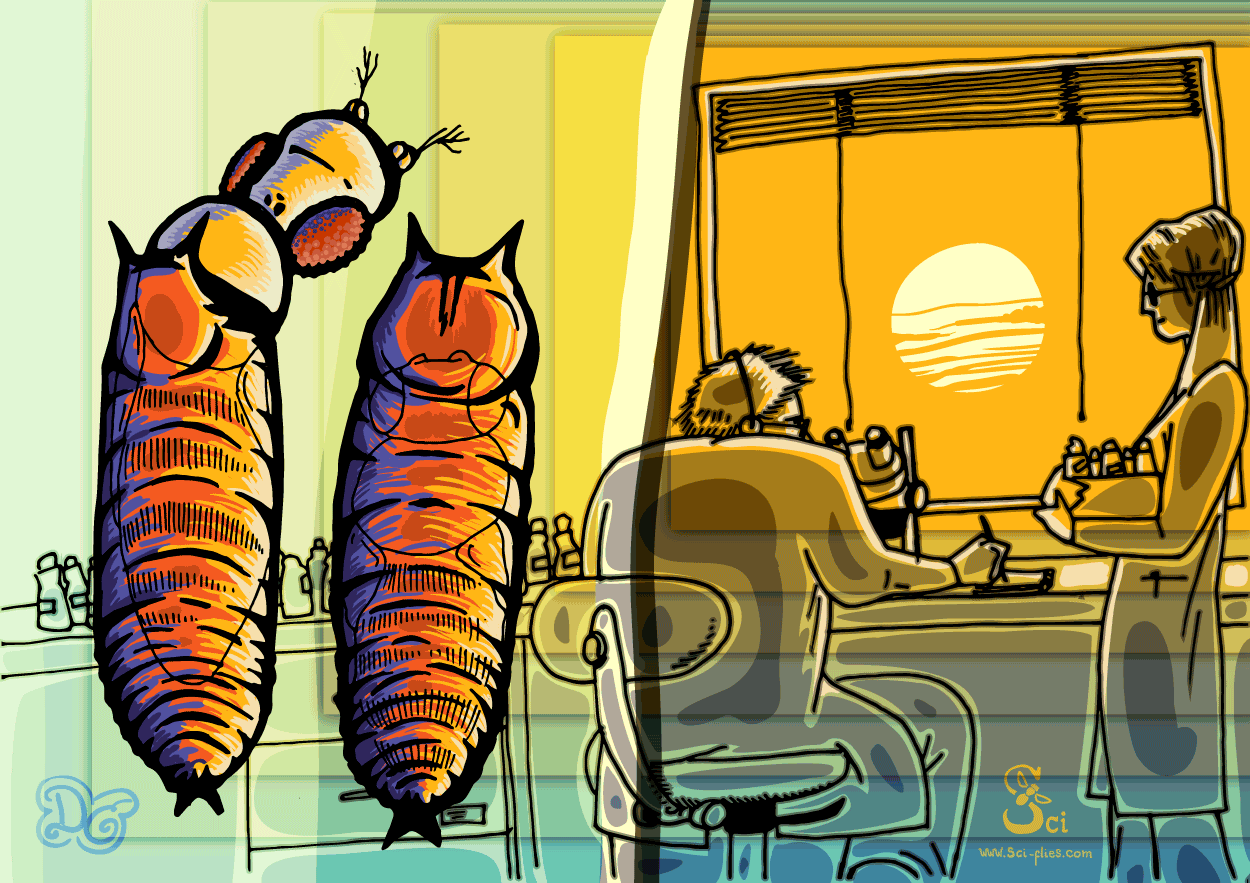
SECOND
How do we measure this behavior?
This can be quantified by checking the bottles or vials were flies are reared at fixed periods of time and counting empty puparia or new adults.
THIRD and FOURTH.
Ron Konopka made mutant flies in the same way Benzer had done and tested if those mutants changed their pattern of emergence from the puparium throughout the day compared to normal flies. He tested 200 mutant lines. He found three interesting lines: one where most of the flies emerged on average 5 hours earlier than normal flies, another that emerged 5 hour later and a third one that did not have a specific rhythm for emergence with flies emerging all through the day and night in the population.
Very exciting stuff, this could be real genetic control of behavior!
You either got rhythm or you don’t. Period - Three alleles of a central component of the clock
Are these mutants really “clock” mutants? Are they affected beyond leaving the puparium? How do they behave during the adult life? Do they have an altered sense of time? How do we know?
During a lunch break at the lab, Konopka talked this over with his colleagues and his boss. Benzer then made use of his ingenuity and background in physics. He proposed to use a spectrophotometer to measure how much flies move during the day (we call this locomotor activity).
A spectrophotometer uses light of very specific colors to quantify the concentration of substances diluted in liquids. But the important part from this machine is that it emits a light from one side of a tube and measures its intensity with a sensor on the other side of the tube. If the light is blocked, the sensor detects this, and the machine records that signal. What can block the light? A fly moving inside of the tube!
After a few tries with the spectrophotometer, they saw that the idea actually could work. So, one of the researchers at the lab made a proper apparatus to use specifically with the flies.
They used thin tubes, with a bit of food on one end and a cap on the other, where a fly could not fly but only walk from one end to the other. Using infrared light (which flies cannot see) and an infrared sensor they could measure how much the fly moved during the whole day, automatically. When the fly walks through the infrared light beam at the center of the tube, the sensor detects this and records a signal (much like the security light beams in heist movies).
In the moments of high activity during the day the fly walks more and passes through the beam very often. During moment of less activity, the fly walks less and does not cross the beam that much.

Normal flies are very active in the morning. Then, during the afternoon, they have a nap time and display little activity. After that, right before sunset, they become very active. Later, they spend the night quietly sleeping (do they sleep? If so, why do they need to sleep? Maybe we can talk about that some other day).
This happens even in total darkness and constant temperature because this cycle is controled by the internal clock. In cyclical phenomena, the duration of a complete turn of the cycle is called a period and defines the perceived day of the fly. A normal fly has a period of around 24 hs, a normal day on Earth.
Konopka and Benzer observed that one of the mutants seemed to have a longer than normal perception of the day. Instead of having periods of 24 hs, that mutant had longer periods that lasted as if their day had 29 hs. Another one of the mutants had an opposite behavior with a perceived day of only 19 hs. The third mutant just did not have any cycle of activity at all, it did not display any repetitive pattern of activity, it had no rhythm, it was arrhythmic.
The next question was where in the genome were those mutations located? To answer this Konopka mapped the gene and got an incredible surprise. The mapping indicated that the three mutants, the short-period one, the long-period one and the arrhythmic one, were located in the same locus (we call a genomic region of interest a locus), this meant they were different mutations in the same gene!
They had found a single gene that controlled the length of the internal day of the fly. Since in Drosophila research when a new gene is discovered it is given a name related to its function, Konopka and Benzer named this new gene Period.
What does the discovery of Period mean to the relationship between genetics and behavior? Why did they find three mutations of the same gene and no mutations of other genes? Was this behavior controlled by a single gene? Are all behaviors controlled by single genes?
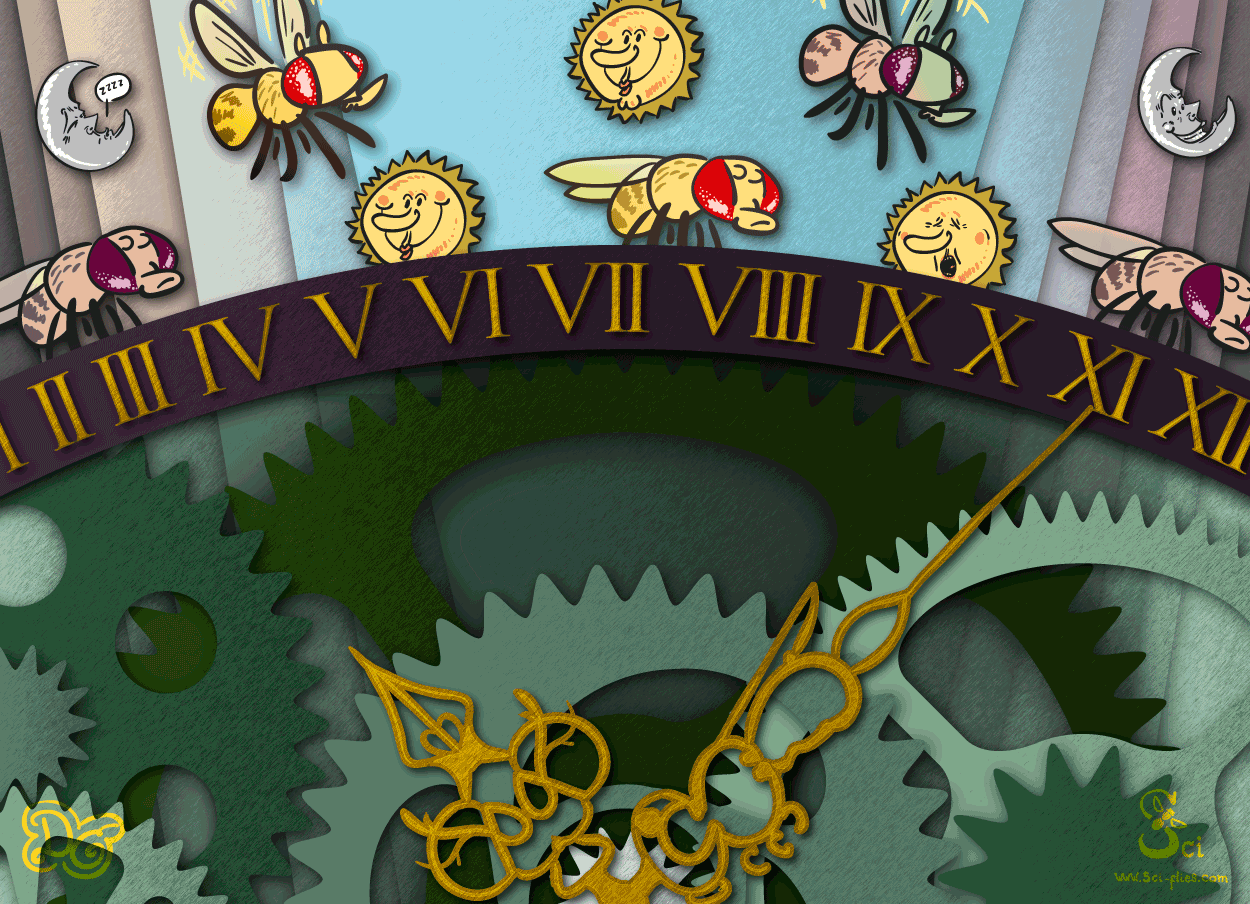
Benzer’s results did not mean that behaviors were controlled by single genes. Konopka and Benzer rightly pointed out on their publication that behaviors are regulated by many genes and that Period was likely to be a central component of the oscillation mechanism of the internal clock, but not the only one. Their methodology was aimed at finding components that drastically affected the clock, components that broke it. There were bound to be other components even with less drastic or central function.
As Hirsch had already shown, the genetic component of behaviors includes many regions of the genome. Those are genes and regulatory regions of DNA that produce many proteins and RNAs of different types that interact with each other in different ways. Some of them are central to those mechanisms and some of them have more subtle functions.
Their research was the foundation for the study of the genetic, cellular and molecular components of the nervous system and how they control behaviors, a field now called neurogenetics. They also founded the study of those components of biological clocks.
Later on, many more elements of the circadian clock were discovered and the mechanisms of their function and the interactions between them described (Rosbash, Hall and Young would be awarded the Nobel prize in 2017 for those studies). It is a field that still produces amazing discoveries that we will continue exploring.
Behaviors are influenced by genetics and by environmental factors. The study of the internal clock has shown many molecular and cellular components that function as sensors of environmental factors such as light or temperature to modulate aspects of its function.
Benzer and his laboratory did not stop at Period 😉, they continued inventing ways to study other behaviors and discovering genes involved in them for many decades. Also, their forward genetics approach would be the bases for many great discoveries in other fields.
Find a biological phenomenon, find a controlled way to measure it in the lab, mutate genes, find mutants for the phenomenon (and work for many years afterwards!).
Can you think of a phenomenon you would like to study in this way? How would you do it? How would you combine Benzer and Konopkas’s discovery with the transgenesis and gene expression techniques we talked about before? Could these methodologies be applied to research related to diseases?
Remember all you can do with the flies!
See you next time!
Interesting References
Benzer died in 2007. After his passing, many tributes were written. For this text I used as sources three very nice account of Benzer’s work (Greenspan R, Current Biology, 2007, vol 18(3) R106-R110;Vosshall LB, Nature, 2007, vol 450(8) pp193-197; Bonini NM, Genetics, 2008, vol 180 pp1265–1273).
I also read the relevant chapters of a nice book about Benzer’s life –Time, Love, Memory: A Great Biologist and His Quest for the Origins of Behavior (1999) by Jonathan Weiner– I recommend it because it is written for the general public interested in science. For this book, the author interviewed Benzer and his coworkers and it is full of anecdotes and details.
I also recommend an article Benzer wrote for Scientific American in 1973 about his discoveries (Genetic Dissection of Behavior, Sci Am, 1973, 229 pp 24–37). It has very nice illustrations in the style of that time (beautiful technical drawings and pictures). And of course, read also the original papers and thesis by Benzer and Konopka (Benzer S, PNAS (1967), vol. 58 pp1112–1119; Konopka RJ and Benzer S, PNAS (1971) vol 68(9) pp 2112-2116; Circadian Clock Mutants of Drosophila melanogaster thesis by RJ Konopka, California Insitute of Technology, 1972).


